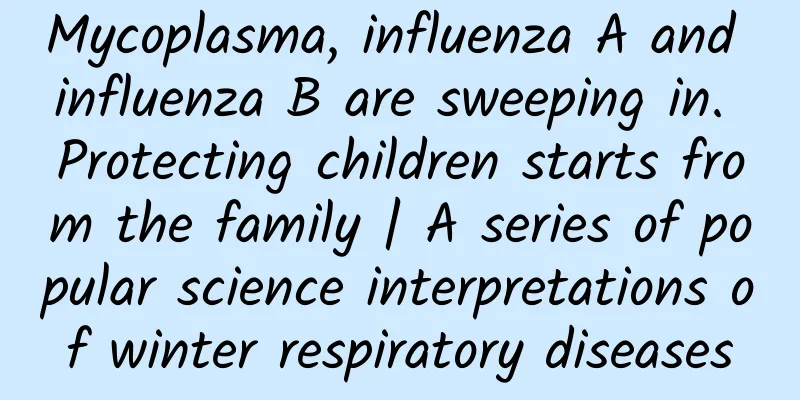Mycoplasma, influenza A and influenza B are sweeping in. Protecting children starts from the family | A series of popular science interpretations of winter respiratory diseases

|
Editor's note: Recently, Guangming Online's Science Channel and the "Dayi Xiaohu" medical communication think tank launched a special topic called "Winter Respiratory Disease Series Popular Science Interpretations", inviting medical experts to provide popular science interpretations on the causes, transmission routes, prevention measures and treatments of respiratory diseases. Please pay attention. Author: Xu Lingmin and Zhao Qing, Department of Pediatrics, Qingpu Branch, Zhongshan Hospital Affiliated to Fudan University Scientific review: Shen Jian, Yueyang Hospital of Integrated Traditional Chinese and Western Medicine, Shanghai University of Traditional Chinese Medicine Recently, the number of pediatric patients has remained high, and many parents and children are struggling with respiratory diseases. Pathogens such as Mycoplasma pneumoniae, influenza A virus, and influenza B virus have attacked one after another, posing a severe challenge to children's health. At this critical moment, the family is the primary line of defense to protect children's health. Although these diseases have different pathogens, their clinical manifestations are similar, with fever, cough, sore throat and other symptoms as the main symptoms. Because children's immune systems are not fully developed and their resistance is weak, they are more vulnerable to these pathogens. Mycoplasma pneumoniae is a pathogenic microorganism between bacteria and viruses, characterized by its lack of cell walls and ability to survive independently. It is the smallest known microorganism that can survive independently and can easily invade and infect the lungs, causing pneumonia. The clinical features of Mycoplasma pneumoniae pneumonia in children include: more common in children over 3 years old, slow onset, and mild poisoning symptoms. Fever, irritating cough, etc. are common. Pulmonary signs are inconsistent with irritating cough and fever, and chest X-ray images show various manifestations. Unlike Mycoplasma pneumoniae, influenza A and influenza B are acute respiratory infectious diseases caused by influenza viruses. The clinical manifestations of influenza A and influenza B are similar, both of which are mainly characterized by sudden fever, cough, sore throat, runny nose or nasal congestion, nausea, vomiting, diarrhea, etc. In severe cases, laryngitis, acute otitis media, acute bronchitis, bronchiolitis, pneumonia, myocarditis, cardiomyopathy, encephalopathy, encephalitis, myositis, etc. may occur. Due to the strong infectivity and rapid spread of influenza viruses, they often cause outbreaks in the population. Facing the invasion of these respiratory diseases, the family becomes the first line of defense to protect children's health. Dr. Xu Lingmin emphasized that parents should do the following in their daily lives: First of all, keep the indoor air circulating and avoid closing doors and windows for a long time. This can reduce the concentration of viruses in the air and reduce the chance of infection. Secondly, we need to develop good hygiene habits. Parents should teach their children to wash their hands frequently, not spit, not litter, etc. When coughing or sneezing, they should cover their mouths and noses with tissues to prevent pathogens from spreading through droplets. In addition, nutrition and exercise should be strengthened. Parents should arrange their children's diet reasonably to ensure balanced nutrition. At the same time, they should encourage their children to participate in more outdoor activities to enhance their physical fitness and immunity. Finally, get vaccinated in time. Flu vaccine is an effective means of preventing flu, and parents should vaccinate their children according to the doctor's advice. At the same time, vaccines for other respiratory diseases should also be administered in time to reduce the risk of infection. When children have symptoms such as fever and cough, parents should not panic. They can use the six-step process of "smile, watch, tease, play, eat, and seek medical treatment" to observe and evaluate the changes in the child's condition at home. First, relax and communicate with the child with a smile; second, observe whether the child's expression is painful, whether the color of the skin and mucous membranes has changed, etc.; then, tease the child, play with the child, observe the child's eating, drinking, defecating, urinating, sleeping, etc.; finally, if any abnormality is found, seek medical treatment in time. If the fever and cough do not improve for more than 3 days, and any abnormality is found during the above-mentioned "smile, watch, tease, play, and eat", you must see a pediatrician immediately. Follow the doctor's advice after seeing the doctor. If the initial doctor thinks that referral or transfer to another hospital is necessary, bring the initial visit record and examination and test data with you so that the second doctor can understand the changes in the condition and help to make a clear diagnosis and treatment as soon as possible. For children with Mycoplasma pneumoniae infection, effective drugs are macrolide antibiotics that act on the cytoplasm, such as azithromycin, erythromycin, clarithromycin, clindamycin, etc. Mycoplasma pneumoniae is inherently resistant to penicillins and cephalosporins that act on the cell wall. If azithromycin and other macrolide antibiotics are resistant, children over 8 years old can use tetracyclines; for children under 8 years old, if it is confirmed that they are infected with azithromycin and other resistant bacteria, in addition to tetracyclines, fluoroquinolones such as levofloxacin and moxifloxacin can also be considered. However, the use of quinolones in children under 18 years old is off-label, and the pros and cons must be fully evaluated, and the informed consent of the parents must be obtained before use. |
Recommend
How to determine whether it is an ectopic pregnancy
Ectopic pregnancy is a disease with a very high i...
What are the causes of high progesterone?
Progesterone is a type of progestin, and the prog...
Rectus abdominis separation
During pregnancy, there may not be any problems, ...
What happens if the endometrium is too thick?
Thick endometrial wall will have a negative impac...
Can I eat ice cream during my period?
Menstruation is a critical period for female frie...
Taboos for women with kidney deficiency, these matters must be kept in mind
If a female friend unfortunately suffers from kid...
Precautions and diet after childbirth
Miscarriage is such a huge blow to every pregnant...
The first menstrual period after IUD insertion was very heavy
Many women have used IUDs for contraception. This...
Can I use slimming cream during breastfeeding? Is it harmful to perm my hair during breastfeeding?
After going through the entire pregnancy period, ...
Can I get pregnant if I have sex 8 days before my period?
Whether pregnancy is possible depends entirely on...
What should I do if myopia occurs while swimming? What should I do if my swimming goggles fog up?
As we all know, people with myopia need to wear m...
Treatment of ovarian endometriosis
Endometriosis is a gynecological disease that man...
What to do if there is blood in the vaginal discharge after taking birth control pills
After taking birth control pills, the leucorrhea ...
What are the symptoms of poor blood circulation in women?
Many women suffer from fear of cold, physical wea...
How big is the belly in 4 months of pregnancy
Not to mention other body changes during pregnanc...









